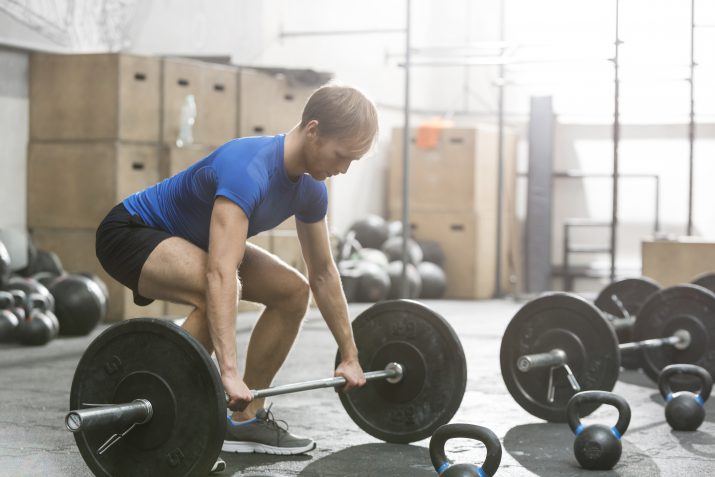A lot of new gym members walk into their local big box gym like L.A. fitness or 24 hours with every intention to realize their goals and gain strength. What usually stops them? Nerves, fear of embarrassment, fear of judgement by others, intimidation of the gym jocks in the free weight area and so on. Read this article to find out the four free weight core lift basics.

This causes people to either:
- attempt to lift free weights without knowing much of anything about it to try to fit in; or
- not lift at all and stick to machines and cardio equipment.
This is detrimental to their growth in fitness and neglects certain small muscle groups throughout the body that are activated when using free weights for exercise. The stabilizing and movement of free weights rather than just linear motion required by machines forces your body to adapt and develop muscles that are vital to overall posture and functional fitness strength.
With that said, let’s get to what I consider to be the core free weight lifts.
Four Free Weight Core Lift Basics
- Bench press
- Barbell row
- Squat
- Deadlift
Each of these involves a barbell. Bench press is primarily chest, row is back, squat is legs and deadlift is back and legs. This is not to say these are the only beneficial free weight exercises using a barbell that are important, just that they are a few of the great ones to start with.
Bench press
A staple of any consistent free weight lifter, bench is a great chest exercise. The barbell helps with stability for novice lifters, and weight can be easily adjusted. The basic technique is to grab the barbell at about shoulder width, un-rack, bring it down to just below your sternum, and press it back up. The most common problems seen are people overarching their backs or not keeping their feet firmly planted on the ground. Your hand placement can be adjusted based on comfort. If going a little wider than shoulder width is more comfortable, do it. Just make sure you don’t spread them too far out or bring them too close unless you intend on performing a variation of the bench press.
Barbell Row
Less common to see than bench press, but one of my personal favorites and an awesome back exercise. This consists of gripping a barbell underhanded or overhand at thigh level, bending at the pelvis so it hangs by the knees, and bringing it back to your belly button (or close there about), and letting it fall back to your knees in a controlled fashion. Key thing to focus on is ensuring your back remains flat throughout and pinching your shoulder blades together at the top of the rep to ensure activation. The distribution of the weight causes the majority of the muscles in the back to be used and it is a great exercise for overall stability and muscle development in the back.
Squat
Specifically barbell back squat. This is one of the best exercises possible to do for all-around fitness. While it engages the vast majority of your body when done correctly, it’s mainly activating your legs. There are a ton of variations on squat, what I recommend starting off is 90 degree parallel squats. Start off with your feet shoulder width apart and the bar on your back, squat down without letting your knees come out to the sides or in, and stop your body at the point that the inside of your thighs and shins make a 90 degree angle, and push with your heels to stand back up straight. Ensure you keep your back flat and straight throughout, stiffening your core helps significantly with ensuring good form. Form on squats is vital to remain safe, as once you load on a lot of weight, your back could suffer serious injury from bad form. This is why you have to take it slow with light weight at first. Focus wholly on form the first few times before adding any kind of weight that causes muscular stress.
Deadlift
Another form intensive but amazingly useful exercise is the barbell deadlift. This is literally pulling a bar off the ground and putting it back down, with the proper form. The deadlift I would begin with if you are just starting out is called the romanian deadlift. The reason I have clients start with this is to build a base of strength before even attempting the more complicated and slightly riskier (without experience) standard deadlift. Romanian’s difference is that they start from the top rather than the bottom. Hold the barbell at thigh level and bend at the pelvis with straight legs till tension is felt in the hamstrings (back of thighs). At this point, straighten back up to standing by activating your hamstrings, back and glutes, keeping a straight back the entire movement. This is guaranteed to work your hamstrings and foster the stability and strength needed to perform a standard deadlift.
There are plenty of other awesome free weight exercises out there, but a thorough understanding and practice of these lifts will help foster the strength and stability needed to move on to more complicated free weight motions.



